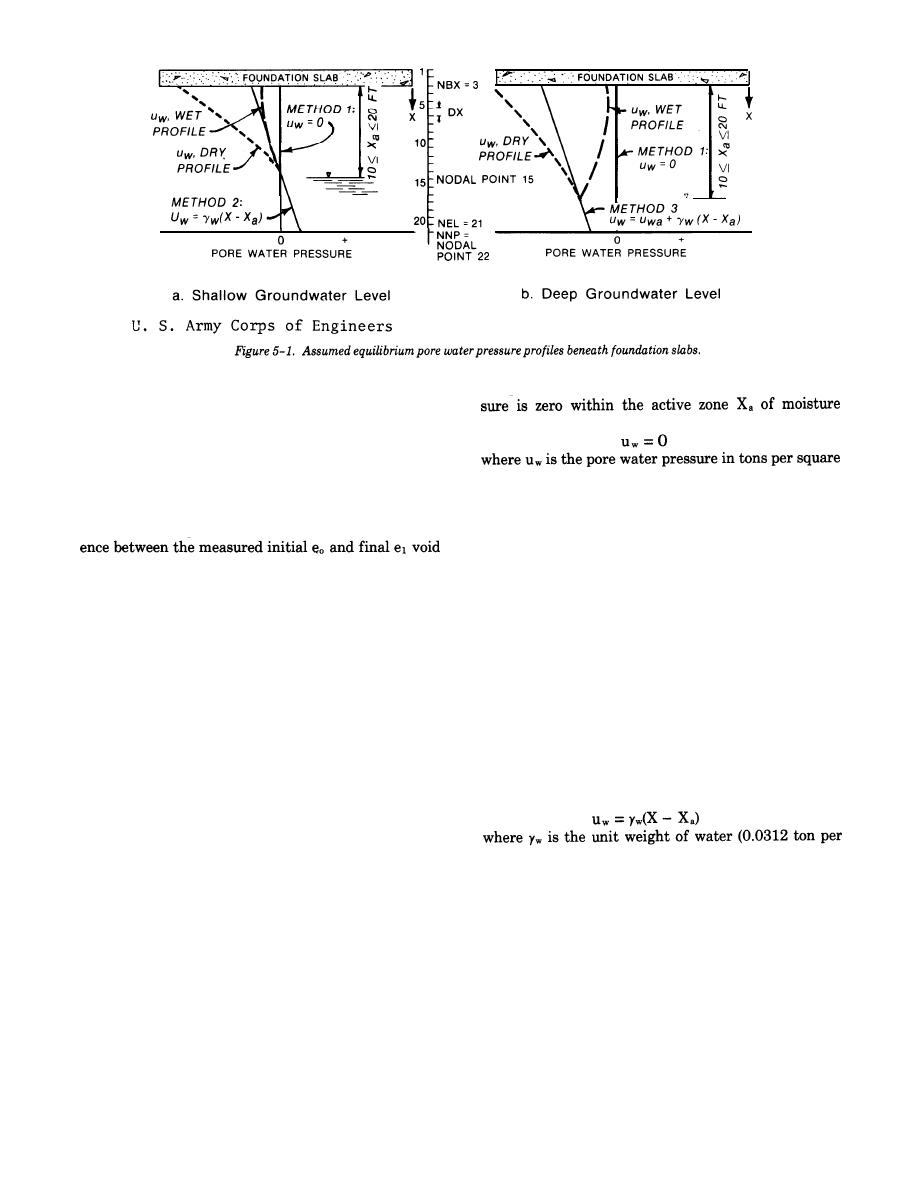
TM 5-818-7
the construction of the foundation.
in figure 5-1, assumes that the in situ pore water pres-
(1) Initial profile. Figure 5-1 illustrates relative
initial dry and wet profiles. The wet initial profile is
change and heave
probably appropriate following the wet season, which
(5-3)
tends to occur by spring, while the dry initial profile
tends to occur during late summer or early fall. The
foot at any depth X in feet within the active zone. Al-
initial pore water pressure profile does not need to be
though a pore water pressure profile of zero is not in
known if the consolidometer swell model is used be-
equilibrium, this profile is considered realistic for
cause the heave prediction is determined by the differ-
most practical cases and includes residences and build-
ings exposed to watering of perimeter vegetation and
ratios (fig. 4-2). The initial void ratio is a function of
possible leaking underground water and sewer lines.
the initial pore water pressure in the soil. The initial
Water may also condense in a layer of permeable sub-
pore water pressure profile, which must be known if
grade soil beneath foundation slabs by transfer of
the soil suction model is used, may be found by the
water vapor from air flowing through the cooler sub-
method described in appendix B.
grade. The accumulated water may penetrate into
underlying expansive soil unless drained or protected
diction of the potential total vertical heave in simulat-
by a moisture barrier. This profile should be used if'
ing the maximum in situ heave depends heavily on the
other information on the equilibrium pore water pres-
ability to properly estimate the equilibrium pore water
sure profile is not available.
pressure profile. This profile is assumed to ultimately
(b) Hydrostatic I. The hydrostatic I profile,
occur beneath the central portion of the foundation.
Method 2 in figure 5-la, assumes that the pore water
The pore water pressure profile beneath the founda-
pressure becomes more negative with increasing verti-
tion perimeter will tend to cycle between dry and wet
cal distance above the groundwater level in proportion
extremes depending on the field environment and
to the unit weight of water
availability of water. The three following assumptions
(5-4)
are proposed to estimate the equilibrium profile. A
fourth possibility, the assumption that the ground-
cubic foot).
water level rises to the ground surface, is most con-
This profile is believed to be more realistic beneath
servative and not normally recommended as being
highways and pavements where drainage is good,
realistic. The equilibrium profile may also be esti-
pending of surface water is avoided, and leaking un-
mated by a moisture diffusion analysis for steady-state
derground water lines are not present. This assump-
flow, which was used to predict differential heave as
tion will lead to smaller predictions of heave than the
part of the procedure developed by the Post-Tension-
saturated profile of Method 1.
ing Institute (PTI) for design and construction of slabs-
(c) Hydrostatic II. This profile, Method 3 in fig
on-grade (para 6-3b). The results, which should be
ure 5-lb, is similar to the hydrostatic I profile except
roughly compatible with the hydrostatic profiles
that a shallow water table does not exist. The negative
discussed in (b) and (c) below, lead to predictions of
pore water pressure of this profile also becomes more
heave smaller than the saturated profile.
(a) Saturated. The saturated profile, Method 1
negative with increasing vertical distance above the
5-3



 Previous Page
Previous Page
